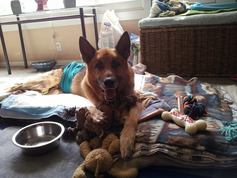How much thought have you given to your pet’s food and water bowls? Pet bowls come in many sizes, colors and styles and of course perform an important function. Here are a few factors to consider when trying to find the right bowl for your pet
For Your Dog
Breed (and size) of your dog.
Take a look at your dog’s anatomy, tiny breeds (Chihuahuas, Yorkies) would need a
small-low sided bowl, but a large breed dog (Golden Retriever, Labs...that wants
to lick the bowl clean) will need a large weighted, or rubber edged bowl to accommodate the quantity and avoid it being pushed around. Long eared dogs (Basset Hounds) need a bowl
with high sides to keep their ears out and long-nosed (collies, afghan hounds)
find it easier to eat from a deeper bowl. However, your shorter faced dogs (pugs, Boston terriers,
bulldogs) find a shallow bowl better suited for their needs.
Age
Senior pets and those with arthritis or degenerative joint disease might find it more comfortable to have the bowl raised, rather than bending down.You can find bowls that sit on a pedestal or you could set it on a box or small table.
Senior pets and those with arthritis or degenerative joint disease might find it more comfortable to have the bowl raised, rather than bending down.You can find bowls that sit on a pedestal or you could set it on a box or small table.
Material
- Ceramic bowls- come in every pattern imaginable, they are more fragile and will require you to be a little more careful and make sure they are sealed.
- Plastic bowls- very durable and easy to care for, plus they also come in many different patterns, however some pets may have sensitivity to plastic.
- Stainless bowls- easy care and comes in variety of sizes, but you do not have the same options in patterns.
Other features-do you want one double bowl or two separate?, self-feeder/water bowls,
self-feeder with timer (great for busy families). Or do you need a slow feeder bowl to help your dog slow down?
For Your Cat
Many of the same elements apply to cats, but often it is more
important on where you feed your cat than in what. Cats generally prefer a calm, quiet place and
often like to eat off the ground (if there is a suitable place) away from small
children and other pets.







